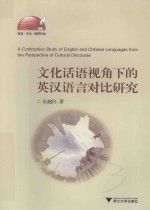图书介绍
文化话语视角下的英汉语言对比研究 英文2025|PDF|Epub|mobi|kindle电子书版本百度云盘下载

- 吴越民著 著
- 出版社: 杭州:浙江大学出版社
- ISBN:9787308145039
- 出版时间:2015
- 标注页数:297页
- 文件大小:40MB
- 文件页数:310页
- 主题词:对比语言学-英语、汉语
PDF下载
下载说明
文化话语视角下的英汉语言对比研究 英文PDF格式电子书版下载
下载的文件为RAR压缩包。需要使用解压软件进行解压得到PDF格式图书。建议使用BT下载工具Free Download Manager进行下载,简称FDM(免费,没有广告,支持多平台)。本站资源全部打包为BT种子。所以需要使用专业的BT下载软件进行下载。如BitComet qBittorrent uTorrent等BT下载工具。迅雷目前由于本站不是热门资源。不推荐使用!后期资源热门了。安装了迅雷也可以迅雷进行下载!
(文件页数 要大于 标注页数,上中下等多册电子书除外)
注意:本站所有压缩包均有解压码: 点击下载压缩包解压工具
图书目录
Chapter 1 Language and Culture1
1.1 Language1
1.1.1 The Definition of Language1
1.1.2 The Components of Language2
1.1.3 The Characteristics of Language5
1.2 Culture12
1.2.1 The Definition of Culture12
1.2.2 The Components of Culture14
1.2.3 The Characteristics of Culture14
1.2.4 The Elements of Cultural Patterns18
1.2.5 High-context and Low-context Cultural Patterns21
1.2.6 Culture and Related Terms25
1.3 Relationship between Language and Culture30
1.3.1 Language Is Part of Culture30
1.3.2 Language Is the Carrier and Container of Culture31
1.3.3 Language Is Strongly Influenced and Shaped by Culture31
1.3.4 Language Exerts Its Influence on Culture32
1.3.5 Language and Culture Influence and Shape Each Other33
Chapter 2 Discourse and Semiotics34
2.1 Discourse34
2.1.1 The Definition of Discourse34
2.1.2 Language and Discourse35
2.1.3 The Definition of Discourse Analysis37
2.1.4 Cultural Discourse39
2.2 Semiotics41
2.2.1 The Definition of Semiotics41
2.2.2 Sign Systems42
2.2.3 Cultural Semiotics45
2.2.4 Codes46
2.2.5 Symbols47
2.2.6 Semiotic Analysis51
Chapter 3 Semantics and Contexts54
3.1 Semantics54
3.1.1 Word Meanings55
3.1.2 Conceptual Meanings and Associative Meanings60
3.2 Contexts62
3.2.1 Social Contexts64
3.2.2 Cultural Contexts65
3.3 Semantic Differences66
3.3.1 Words with Basically the Same Conceptual and Associative Meanings68
3.3.2 Different Words Conveying the Same Cultural Meanings68
3.3.3 Same Words Conveying Different Associative Meanings69
3.3.4 Words with Surface Similarity but Actual Semantic Differences73
3.3.5 Lexical Gaps in Different Cultures74
Chapter 4 Animals and Plants77
4.1 Animals77
4.1.1 Dog(狗)79
4.1.2 Fish(鱼)80
4.1.3 Sheep(羊)82
4.1.4 Horse(马)83
4.1.5 Lion(狮)84
4.1.6 Tiger(虎)85
4.1.7 Cattle(牛)86
4.1.8 Rabbit(兔)88
4.1.9 Tortoise(龟)89
4.1.10 Owl(猫头鹰)90
4.1.11 Bat(蝙蝠)92
4.1.12 Crane(仙鹤)92
4.1.13 Magpie(喜鹊)93
4.2 Plants94
4.2.1 Rose(玫瑰)94
4.2.2 Plum(梅),Orchid(兰),Bamboo(竹)and Chrysanthemum(菊)95
4.2.3 Pine(松)97
4.2.4 Bodhi Tree(菩提树)98
4.2.5 Lotus(莲花,荷花)98
4.2.6 Apple(苹果)99
4.2.7 Peach(桃)101
4.2.8 Willow(柳)102
Chapter 5 Colors and Numbers104
5.1 Colors104
5.1.1 Red(红)106
5.1.2 White(白)111
5.1.3 Black(黑)113
5.1.4 Green(绿)115
5.1.5 Yellow(黄)117
5.1.6 Blue(蓝)119
5.1.7 Grey(灰)120
5.1.8 Pink(粉红)120
5.1.9 Purple(紫)121
5.2 Numbers121
5.2.1 One(一)122
5.2.2 Two(二)123
5.2.3 Three(三)123
5.2.4 Four(四)130
5.2.5 Five (五)134
5.2.6 Six (六)137
5.2.7 Seven(七)138
5.2.8 Eight(八)139
5.2.9 Nine(九)140
5.2.10 Ten(十)141
5.2.11 Thirteen(十三)142
Chapter 6 Grammar and Text144
6.1 Grammar144
6.1.1 Morphemes145
6.1.2 Syntactical Rules147
6.1.3 Explicit Grammar and Implicit Grammar149
6.1.4 Subjects and Objects150
6.1.5 Paratactic and Hypotactic Relations151
6.1.6 Branching and Linear Sentence Patterns152
6.1.7 Word Order153
6.1.8 Cultural Differences behind Grammar154
6.2 Text156
6.2.1 The Definition of Text157
6.2.2 Cohesion and Coherence157
6.2.3 Textual Connectives158
6.2.4 Textual Structures162
6.2.5 Cultural Differences behind Text166
Chapter 7 Simile and Metaphor172
7.1 Simile172
7.1.1 The Definition of Simile173
7.1.2 Cultural-alike Associations in English and Chinese Similes174
7.1.3 Cultural-distinct Associations in English and Chinese Similes175
7.2 Metaphor177
7.2.1 The Definition of Metaphor177
7.2.2 Cultural Metaphors178
7.2.3 Cultural-alike Associations in English and Chinese Metaphors181
7.2.4 Cultural-distinct Associations in English and Chinese Metaphors182
7.3 Translation184
7.3.1 Literal Translation185
7.3.2 Cultural Translation188
Chapter 8 Idioms and Proverbs191
8.1 Idioms191
8.1.1 Cultural Similarities between Chinese and English Idioms193
8.1.2 Cultural Disparities between Chinese and English Idioms193
8.2 Proverbs197
8.2.1 Some Equivalent Proverbs in English and Chinese198
8.2.2 Proverbs Related to Different Religions198
8.2.3 Proverbs Derived from Literary Works201
8.2.4 Proverbs Originating from Geographical Environments202
8.2.5 Proverbs Reflecting Values and Viewpoints204
Chapter 9 Allusions and Euphemisms214
9.1 Allusions214
9.1.1 Allusions from Literature215
9.1.2 Allusions from History220
9.1.3 Allusions from Mythology and Legends221
9.1.4 Allusions from Sports225
9.1.5 The Contrastive Analysis of English and Chinese Allusions227
9.2 Euphemisms228
9.2.1 To Avoid Taboos229
9.2.2 To Show Politeness233
9.2.3 To Conceal Truth236
Chapter 10 Taboos and Sexism239
10.1 Taboos239
10.1.1 The Definition of Taboo240
10.1.2 Verbal Taboos in Different Cultures240
10.1.3 Nonverbal Taboos in Different Cultures245
10.2 Sexism249
10.2.1 Sexist Language in English250
10.2.2 Sexist Language in Chinese257
Chapter 11 Advertising and Culture261
11.1 The Definition of Advertising261
11.2 The Development of Advertising262
11.2.1 The Evolution of Western Advertising262
11.2.2 Chinese Economic Reform and Advertising264
11.3 The Techniques of Advertising266
11.4 The Linguistic Features of Advertising267
11.4.1 Phonetic Features of Advertisements268
11.4.2 Lexical Features of Advertisements269
11.4.3 Rhetorical Devices of Advertisements271
11.5 Brand Names274
11.5.1 Brand Names and Cultural Connotations275
11.5.2 Coinages in English and Chinese Brand Names276
11.5.3 Exotic Flavor in English and Chinese Brand Names276
11.5.4 Cultural Connotations in English and Chinese Brand Names277
11.6 Logos278
11.7 Cultural Differences in English and Chinese Advertising280
11.7.1 Advertising Legislations in Different Cultures280
11.7.2 Family Image in Chinese Advertisements281
11.7.3 Authoritative Worship and Factual Proofs282
11.7.4 Collective Orientation and Individualistic Centeredness283
Glossary(Index of Important Terms)286
Bibliography294
热门推荐
- 1060989.html
- 2052598.html
- 958056.html
- 2100292.html
- 207618.html
- 2539688.html
- 2609606.html
- 2010032.html
- 833420.html
- 873537.html
- http://www.ickdjs.cc/book_3507297.html
- http://www.ickdjs.cc/book_3248610.html
- http://www.ickdjs.cc/book_1835252.html
- http://www.ickdjs.cc/book_401916.html
- http://www.ickdjs.cc/book_1489441.html
- http://www.ickdjs.cc/book_1334410.html
- http://www.ickdjs.cc/book_2763140.html
- http://www.ickdjs.cc/book_3029394.html
- http://www.ickdjs.cc/book_3828166.html
- http://www.ickdjs.cc/book_283142.html